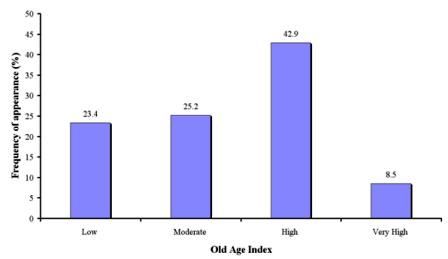Old age index
The old age index measures the relationship between the populations over the age of 65 divided by the total population. The purpose of the indicator is to emphasize the strong imbalance that exists between the large numbers of elderly people in relations to the total population. This index is related to the applied land management practices and to the introduction of new technologies. Elder people used to remain under the traditional land management practices, while younger farmers are relatively easily convinced to introduce new technologies and land management practices, considering sustainability of land resources. Furthermore, elder people in dry lands are not usually replaced in farming by their sons and the land is often abandoned or land management practice or land use changes leading later to abandonment after possible further degradation.
The old age index (R) has been calculated by the following equation:
![]()
Data for calculation of this indicator have been collected from the National Statistical Service of the corresponding study sites. The following classes of old age index have been distinguished for this project: (a) low- old age index R<5, (b) moderate- R=5-10, (c) high- R=10-20, and (d) very high- R>20.
Data for this indicator have been defined in 1056 study field sites, corresponding to 10 study sites (Table 14). As Fig. 95 shows, the old age index is mainly characterized as high, covering 42.9% of the study field sites. Such index has been identified in all cases of the study sites of Guadalentin Basin Murcia-Spain, Eskisehir-Turkey, Konya Karapinar plain-Turkey, and Crete-Greece, and in some cases in the study sites of Boteti Area-Botswana, and Santiago Island-Cape Verde. Moderate was the next important class of old age index, covering 25.2% of the study field sites, and corresponding to the study sites of Djanybek-Russia, Cointzio Catchment-Mexico, Santiago Island-Cape Verde, and Zeuss Koutine-Tunisia. Low old age index has been defined in 23.4% of the study field sites, corresponding to the study sites of Boteti Area-Botswana, Novij Saratov-Russia, Santiago Island-Cape Verde, Mamora Sehoul-Morocco, and Zeuss Koutine-Tunisia. Finally, very high old age index has been identified in 8.5% of the study field sites, corresponding to Novij Saratov-Russia, Secano Interior-Chile, and Djanybek-Russia study sites.

Fig. 95. Distribution of old age index classes defined in the study field sites